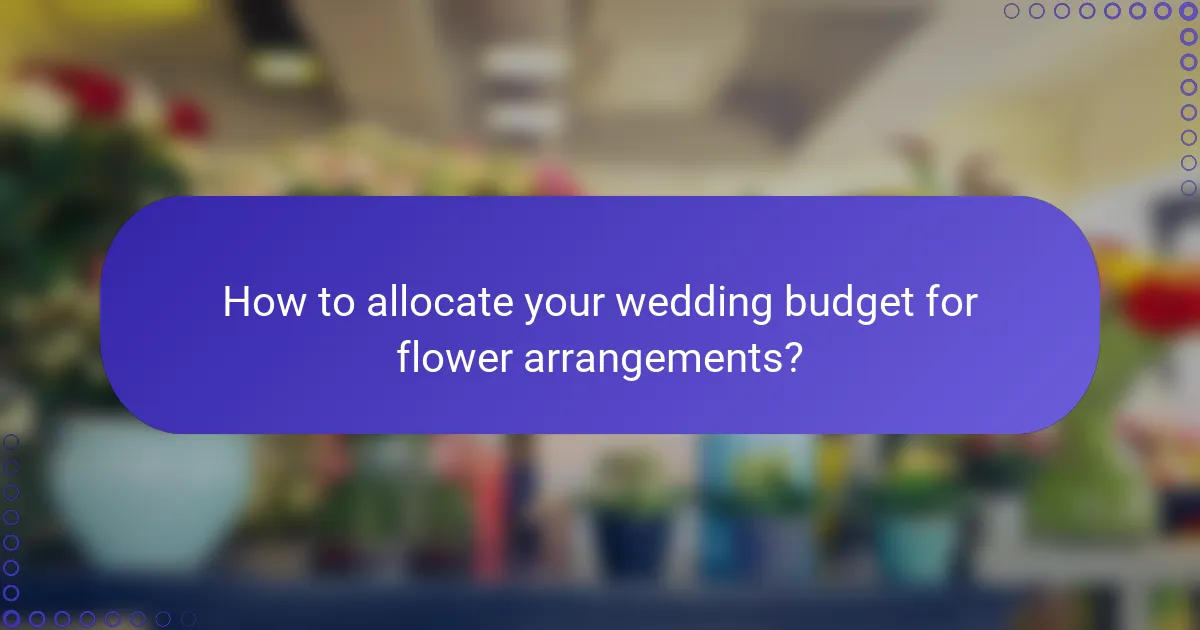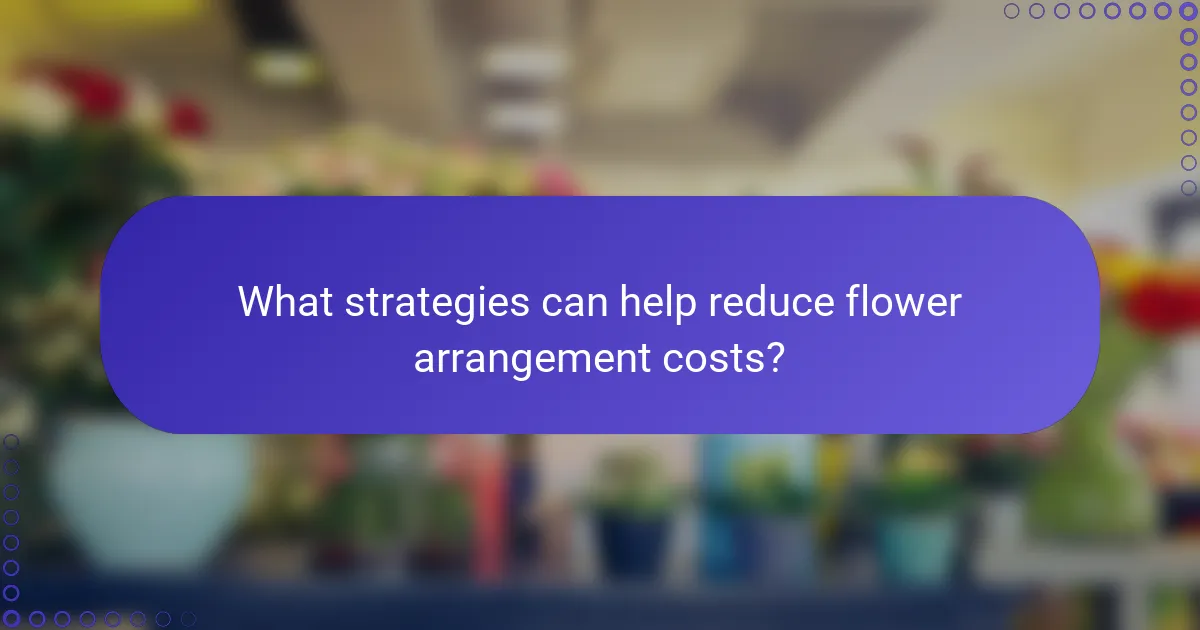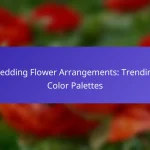When planning your wedding, effectively allocating your budget for flower arrangements is crucial to achieving the desired aesthetic while staying financially responsible. By prioritizing key elements such as bouquets, centerpieces, and ceremony decor, you can ensure that your floral choices not only enhance the beauty of your event but also align with your overall budget. A strategic approach will help you balance quality and quantity, making your special day memorable without overspending.

How to allocate your wedding budget for flower arrangements?
To effectively allocate your wedding budget for flower arrangements, prioritize your floral needs based on the significance of each element, such as bouquets, centerpieces, and ceremony decor. Aim to balance quality and quantity while considering overall wedding costs to ensure your floral choices enhance the event without overspending.
Percentage breakdown for flower costs
A common guideline for allocating your wedding budget to flower arrangements is to set aside about 10-15% of your total budget for floral expenses. This percentage can vary based on personal preferences and the scale of the wedding. For example, if your total budget is $20,000, you might allocate between $2,000 and $3,000 for flowers.
Within this budget, you can further break down costs by assigning specific percentages to different floral elements. For instance, you might allocate 40% for bouquets, 30% for centerpieces, and 30% for ceremony decorations.
Factors influencing flower arrangement expenses
Several factors can influence the expenses associated with flower arrangements. Seasonal availability of flowers can significantly impact costs; opting for in-season blooms typically reduces expenses. Additionally, the complexity of the arrangements and the florist’s experience level can also affect pricing.
Venue size and location play a role as well. Larger venues may require more flowers to achieve the desired aesthetic, while florists in urban areas might charge higher rates due to increased demand and overhead costs.
Common budget ranges for weddings
Wedding flower budgets can vary widely, but many couples spend between $1,500 and $5,000 on floral arrangements. Smaller weddings may find that a budget of $1,500 suffices for basic floral needs, while larger celebrations might require upwards of $5,000 for elaborate designs and extensive decor.
When planning your budget, consider the type of wedding you are hosting. For a more intimate gathering, you might focus on fewer, high-impact arrangements, while a grand celebration may necessitate a broader floral presence throughout the venue.

What are the most important flower arrangements for weddings?
The most important flower arrangements for weddings typically include the bridal bouquet, ceremony floral displays, and reception centerpieces. These elements not only enhance the aesthetic appeal but also carry significant emotional and symbolic value throughout the event.
Bridal bouquet significance
The bridal bouquet is a central floral arrangement that symbolizes love and commitment. Traditionally, it is crafted with the bride’s favorite flowers or those that hold personal significance, making it a unique reflection of her personality.
When selecting a bridal bouquet, consider the seasonality of flowers, as this can affect both availability and cost. Bouquets can range from simple, understated designs to elaborate arrangements, typically costing anywhere from a few hundred to over a thousand dollars, depending on the flowers used and the complexity of the design.
Ceremony floral displays
Ceremony floral displays set the tone for the wedding and can transform the venue into a romantic setting. Common arrangements include altar flowers, aisle markers, and floral arches, which can be tailored to match the wedding theme and color palette.
When budgeting for ceremony displays, allocate funds based on visibility and impact. For example, larger installations like arches may require a higher investment, while smaller aisle markers can be more cost-effective. A typical budget range for ceremony flowers might be around 10-20% of the total floral budget.
Reception centerpieces
Reception centerpieces are essential for creating a welcoming atmosphere during the celebration. These arrangements can vary widely in style, from elegant floral arrangements to creative alternatives like candles or themed decor.
When planning centerpieces, consider the size of the tables and the overall layout of the reception space. A good rule of thumb is to keep centerpieces at a height that allows for easy conversation across the table. Budgeting for centerpieces can typically take up about 30-50% of the total floral budget, depending on the number of tables and the complexity of the designs.

How to prioritize flower arrangements in your wedding budget?
Prioritizing flower arrangements in your wedding budget involves identifying essential floral elements, balancing visual appeal with costs, and consulting with florists to align your vision with your budget. This strategic approach ensures that your floral choices enhance your wedding without overspending.
Identifying key floral elements
Start by determining which floral arrangements are essential for your wedding. Common priorities include bridal bouquets, boutonnieres, centerpieces, and ceremony decorations. Each element plays a unique role in the overall aesthetic and should be evaluated based on its significance to your wedding theme.
Consider the venue and season when selecting flowers. For instance, local blooms in season can be more cost-effective and visually appealing. Make a list of must-have arrangements and rank them based on importance to help guide your budget allocation.
Balancing aesthetics and costs
Finding the right balance between aesthetics and costs is crucial. High-impact arrangements, like large centerpieces or dramatic altar displays, can elevate your wedding’s look but may also consume a significant portion of your budget. Aim for a mix of statement pieces and simpler arrangements to maintain visual interest without overspending.
Utilize seasonal flowers and greenery to reduce costs while maintaining beauty. For example, opting for in-season blooms can save you money and ensure freshness. Additionally, consider using fewer flowers in larger arrangements to create a striking effect without the expense of numerous individual blooms.
Consulting with florists for priorities
Engaging with professional florists can provide valuable insights into prioritizing your floral arrangements. Florists can help you understand which flowers are in season, suggest cost-effective alternatives, and recommend arrangements that fit your budget while achieving your desired look.
When meeting with florists, be clear about your budget and priorities. Share your vision and ask for their expertise on how to best allocate your funds. This collaboration can lead to creative solutions that enhance your wedding’s floral design while keeping costs manageable.

What strategies can help reduce flower arrangement costs?
To reduce flower arrangement costs, consider strategies such as selecting seasonal blooms, creating DIY arrangements, and working with local florists. These approaches can significantly lower expenses while still achieving a beautiful floral display for your wedding.
Choosing seasonal flowers
Opting for seasonal flowers is one of the most effective ways to cut costs on floral arrangements. Seasonal blooms are typically more abundant and readily available, which can lower their price compared to out-of-season varieties. For example, in spring, consider tulips and daffodils, while summer offers sunflowers and peonies.
Additionally, local availability can enhance freshness and reduce transportation costs. Research local flower markets or consult with florists to identify which flowers are in season during your wedding month.
DIY flower arrangements
Creating your own flower arrangements can save a significant amount of money. By purchasing flowers in bulk from wholesalers or local markets, you can control costs and customize arrangements to fit your vision. Gather supplies such as vases, floral foam, and tools to get started.
Consider hosting a flower arranging party with friends or family to make the process enjoyable and collaborative. Just be sure to allocate enough time for preparation and practice to ensure the final results are beautiful.
Utilizing local florists
Working with local florists can provide cost-effective solutions tailored to your budget. Local florists often have established relationships with growers, allowing them to source flowers at lower prices. They can also offer valuable advice on which flowers will look best and fit within your budget.
When approaching florists, be clear about your budget and preferences. Request quotes from multiple florists to compare prices and services, and don’t hesitate to negotiate or ask for package deals that include delivery and setup.

What are the best flower arrangement trends for weddings in 2024?
In 2024, the best flower arrangement trends for weddings focus on vibrant colors, unique designs, and sustainability. Couples are increasingly opting for arrangements that reflect their personal style while being mindful of environmental impact.
Popular color palettes
This year, bold and contrasting color palettes are making a statement. Shades like deep burgundy paired with soft blush or vibrant orange with muted greens create striking visuals that enhance wedding themes.
Pastel colors remain popular, particularly soft lavenders and pale yellows, which evoke a romantic atmosphere. Couples should consider their venue and overall theme when selecting a color palette to ensure cohesion throughout their decor.
Unique floral designs
Couples are moving away from traditional arrangements and embracing unique floral designs such as asymmetrical bouquets and installations that incorporate unexpected elements like dried flowers or foliage. These designs add a modern touch and can be customized to reflect personal stories.
Floral arches and hanging installations are also trending, creating stunning focal points for ceremonies and receptions. Consider incorporating local flowers to enhance the uniqueness and support local growers.
Eco-friendly options
Eco-friendly flower arrangements are increasingly sought after, with many couples opting for seasonal blooms and locally sourced flowers to reduce their carbon footprint. This approach not only supports local economies but also ensures fresher arrangements.
Additionally, using biodegradable materials for floral foam and compostable packaging can further enhance sustainability. Couples should discuss eco-friendly options with their florists to create beautiful arrangements that align with their values.

How to evaluate floral vendors for your wedding?
To evaluate floral vendors for your wedding, focus on their reputation, pricing, and service offerings. This ensures you choose a vendor who aligns with your budget and vision while providing reliable support on your special day.
Checking reviews and portfolios
Start by researching vendor reviews on platforms like Google, Yelp, or wedding-specific sites. Look for consistent positive feedback and any red flags in customer experiences.
Additionally, review their portfolios to assess the quality and style of their previous work. Ensure their floral designs resonate with your wedding theme and personal taste.
Understanding pricing structures
Floral pricing can vary significantly based on factors such as flower types, arrangement complexity, and seasonal availability. Expect to see packages ranging from a few hundred to several thousand dollars, depending on your needs.
Ask vendors for detailed quotes that break down costs for bouquets, centerpieces, and other arrangements. This transparency helps you compare options and stay within your budget.
Asking about delivery and setup services
Inquire whether the vendor includes delivery and setup in their service package. Some vendors may charge extra for these services, which can add to your overall costs.
Clarify the timeline for delivery and setup on your wedding day to ensure everything is in place before guests arrive. A reliable vendor will have a clear plan for timely execution, minimizing stress on your big day.


